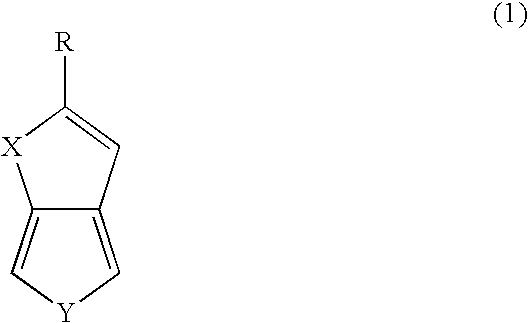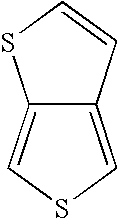Heterocyclic Fused Selenophene Monomers
- Summary
- Abstract
- Description
- Claims
- Application Information
AI Technical Summary
Benefits of technology
Problems solved by technology
Method used
Image
Examples
example 1
[0054]The compound selenolo[2,3-c]thiophene was prepared in a single reaction mixture in accordance with the method of the present disclosure.
A solution of 2-bromomethyl-4-trimethylsilanyl-but-1-en-3-yne-1-thiol (5.00 g, 19.3 mmol) in ether (19.3 mL) under N2 was cooled to −80° C. Maintaining the temperature below −50° C., n-butyl lithium (2.5 M in hexanes, 7.60 mL, 19.3 mmol) was added. The reaction was allowed to warm to −20° C. and then was cooled to −30° C. Selenium powder (1.60 g, 20.3 mmol) was added in one portion and stirred at −5° C. for 1 h. The reaction was cooled to −30° C., water (19.3 mL) was added, and the mixture was agitated vigorously for 20 seconds. The phases were split immediately. The ether layer was extracted with cold water (5.00 mL). The aqueous layers were combined and heated to 70° C. for 1.5 h. Upon cooling to room temperature the reaction mixture was extracted with MTBE (3×20.0 mL). The combined MTBE extracts were dried over magnesium sulfate and concent...
example 2
[0055]The compound selenolo[3,4-b]selenophene was prepared in a series of reactions in accordance with the method of the present disclosure.
[0056]To a stirred slurry of 2,3,4,5-tetrabromo-selenophene (6.20 g, 13.9 mmol) in acetic acid (10.0 mL) and water (20.0 mL) under N2 was added zinc (2.90 g, 45.1 mmol). The mixture was heated to 100° C. for 3 h. The reaction mixture was extracted with MTBE. The MTBE extracts were quenched with saturated sodium bicarbonate until the pH was 7-8. The organic was dried over sodium sulfate, filtered, and concentrated to an oil. The crude oil was purified by column chromatography (silica gel, heptane) to provide 3,4-dibromo-selenophene (1.95 g, 6.75 mmol, 48.6 mol %): 500 MHz 1H NMR (CDCl3) δ 7.93 (s, 2H); 125 MHz 13C NMR (CDCl3) δ 127, 114.
[0057]To a pressure vessel purged with N2 was added 3,4-dibromo-selenophene (3.69 g, 12.77 mmol), DMF (10.0 mL), triphenylphosphine (0.669 g, 2.55 mmol), copper(I) iodide (0.161 g, 0.843 mmol), diethylamine (dried...
example 3
[0059]The compound selenolo[3,4-b]thiophene was prepared in a series of reactions in accordance with the method of the present disclosure.
[0060]To a stirred slurry of 2,3,4,5-tetrabromo-selenophene (6.20 g, 13.9 mmol) in acetic acid (10.0 mL) and water (20.0 mL) under N2 was added zinc (2.90 g, 45.1 mmol). The mixture was heated to 100° C. for 3 h. The reaction mixture was extracted with MTBE. The MTBE extracts were quenched with saturated sodium bicarbonate until the pH was 7-8. The organic was dried over sodium sulfate, filtered, and concentrated to an oil. The crude oil was purified by column chromatography (silica gel, heptane) to provide 3,4-dibromo-selenophene (1.95 g, 6.75 mmol, 48.6 mol %): 500 MHz 1H NMR (CDCl3) δ 7.93 (s, 2H); 125 MHz 13C NMR (CDCl3) δ 127, 114.
[0061]To a pressure vessel purged with N2 was added 3,4-dibromo-selenophene (3.69 g, 12.77 mmol), DMF (10.0 mL), triphenylphosphine (0.669 g, 2.55 mmol), copper(I) iodide (0.161 g, 0.843 mmol), diethylamine (dried o...
PUM
 Login to View More
Login to View More Abstract
Description
Claims
Application Information
 Login to View More
Login to View More - R&D
- Intellectual Property
- Life Sciences
- Materials
- Tech Scout
- Unparalleled Data Quality
- Higher Quality Content
- 60% Fewer Hallucinations
Browse by: Latest US Patents, China's latest patents, Technical Efficacy Thesaurus, Application Domain, Technology Topic, Popular Technical Reports.
© 2025 PatSnap. All rights reserved.Legal|Privacy policy|Modern Slavery Act Transparency Statement|Sitemap|About US| Contact US: help@patsnap.com



